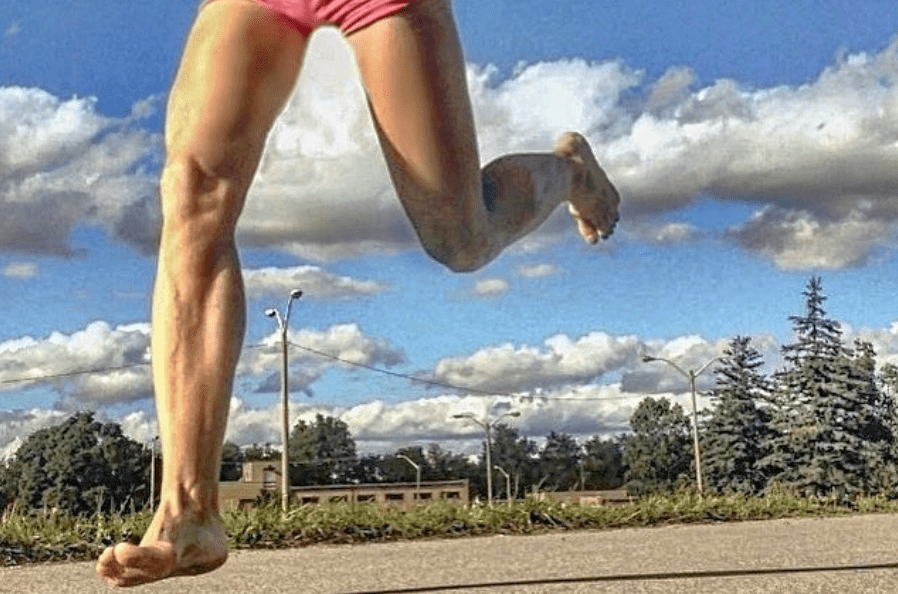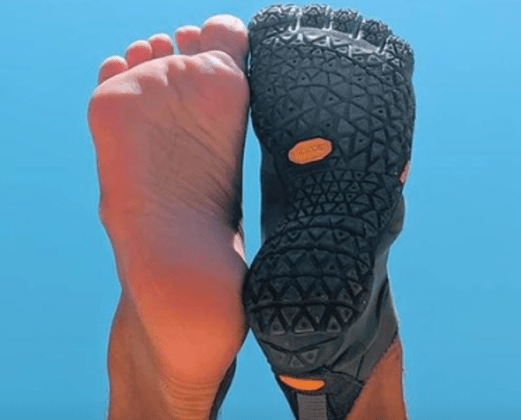Going barefoot more often as well as doing more training barefoot or in minimalist shoes takes the lead in making you more balanced when you run in your regular running shoes.

Walking and running barefoot leads to quicker adaptations in sturdier balance because the heightened ground-feel translates into improvements muscle control as compared with thicker cushioned footwear. Not to mention, the more you go barefoot, the stronger your feet will be because for one, the feet are working independently the way they should. For another, the sensory-feel of the ground is the most powerful component in making your foot stronger because it directly stimulates the soft tissues, muscles and vasculature networks in the feet.
Equally important, if going barefoot doesn’t interest you, spending more time walking and training in minimalist (barefoot-like) shoes (shown below) gives you enough multiple sensory inputs that will help you develop better balance stability. Conversely, routine use of thick cushioned footwear without any barefoot intervention robs the feet of the sensory input they need to keep going strong and sturdy.
Bottom line, better balance as well as foot strength progress has to grow from sensory-input whereas in thick cushioned running shoes, the sensory feedback isn’t there which is of little help in keeping you sustainably balanced.
For example, a 2015 study in the International Journal of Sports Physiscal Therapy examined static standing balance in participants that were barefoot, wearing the Vibram FiveFingers (minimalist shoes) and regular cushioned running shoes with their eyes closed.
The researchers found that the Vibram FiveFingers and being barefoot provided better stability by a long shot as compared with regular cushioned footwear.
Unsurprisingly, the researchers found that participants in the regular cushioned running shoes spent most of the time trying to resist balance disruption as these shoes instantly caused balance impairments and was an obstructive reinforcement for adequate toe splay.
More proof of the destabilizing effects of cushioned running shoes came from a 2008 study in the Archives of Physical Medicine and Rehabilitation which found that footwear with thick, soft and squishy underfoot cushioning led to the poorest outcomes in balance control because of the greater distance separation between the foot and the ground and limited sensory feedback. In contrast, balance impairments occurred the least when subjects wore thinner footwear while walking on a balance beam.
The researchers concluded that thick cushioned footwear is detrimental to joint-position awareness, making you less likely to maintain proper lower leg joint position while running which in turn causes uneven tendon stress,
The Take Home Message
The research is pretty straightforward that one of the main threats to your balance is thick cushioned footwear because these shoes under-provide the sensory stimulation found to be incredibly effective in improving both static and dynamic balance. This is why you should always put barefoot and/or minimalist running first because optimal stability and ground-feel go hand in hand as it triggers reflexive responses that are important for creating stable footholds.

References:
Menant JC, Perry SD, Steele JR etal. Effects of shoe characteristics on dynamic stability when walking on even and uneven surfaces in young and older people. Arch Phys Med Rehabil. 2008; 89(10):1970-
1976.
Smith et al. EFFECTS OF WEARING ATHLETIC SHOES, FIVE-TOED SHOES, AND STANDING BAREFOOT ON BALANCE PERFORMANCE IN YOUNG ADULTS. Int J Sports Phys Ther, 2015; 10(1):69-74.
If you enjoyed my post on barefoot running, you’ll love my YouTube channel, here, where I talk more about the evidence-based reasons barefoot running will be an enormous asset to your performance.
If you’d like, you can support Run Forefoot and help keep it going by making a donation in any amount of your choosing:

Or, you can also support Run Forefoot by shopping at the following top minimalist shoes brands, and be sure to bookmark the links:
Be Lenka: https://www.dpbolvw.net/click-7600968-14330828
Xero Shoes: https://xeroshoes.com/go/Run_Forefoot
Iguaneye: https://www.iguaneye.com/?ref=8tfXVc92
Soft Star Shoes: https://shrsl.com/3mp1b
Wilding Shoes: https://bit.ly/3lIygQP
Vivobarefoot: https://shrsl.com/3kvih
Zappos: https://goo.gl/J1CeAd
Bretta Riches
BSc Neurobiology; MSc Biomechanics candidate, ultra minimalist runner & founder of RunForefoot. I was a heel striker, always injured. I was inspired by the great Tirunesh Dibaba to try forefoot running. Now, I'm injury free. This is why I launched Run Forefoot, to advocate the health & performance benefits of forefoot running and to raise awareness on the dangers of heel striking, because the world needs to know.
Latest posts by Bretta Riches (see all)
- Can You Run In Barefoot Shoes? Yes, But DON’T Heel Strike! - 21/07/2024
- Why Cushioned Running Shoes Are Really Bad for Your Feet - 19/07/2024
- Do Cushioned Running Shoes Cause Injuries? - 17/07/2024

